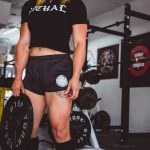If you’re hitting the gym regularly but not seeing the muscle gains you expect, it might be time to evaluate your training intensity. Muscle growth only happens when your workouts challenge your muscles enough to force adaptation. Here are six telltale signs that your training isn’t pushing hard enough, and how to fix it.
1. Your sets feel too easy
Are you watching the clock during your higher-rep sets?
Scrolling on your phone mindlessly while on the adductor machine?
Gossiping with your gym buddy mid-squat?
These are all signs your training intensity could improve. If you can complete all your sets and reps without significant effort, it’s a sign your muscles aren’t being sufficiently challenged. For muscle growth, aim to train close to muscular failure—the point where completing another rep with good form would be difficult or even impossible. As a general rule, the last 2-3 reps of your sets should be challenging enough that you have to fight to maintain good form.
2. You rarely or never have sore muscles
If you’ve never struggled to sit down or get off the toilet the day after training legs, you might not be training them hard enough.
DOMS (Delayed Onset Muscle Soreness) is an indicator of muscle fibers being stressed and micro-tears occurring, which signals your body to repair and strengthen the muscles. While soreness isn’t required for growth, never feeling any post-workout fatigue or mild soreness can suggest that your muscles aren’t being challenged enough to stimulate adaptation and muscle growth.
3. You’re not getting a pump
The “pump” is that tight, swollen feeling you get in your muscles during a workout, caused by blood filling the muscle tissue.
It’s not the only indicator of a good workout, but if you never feel it, it can signal that you’re not fully engaging your muscles. A good pump means you’re recruiting fibers, creating metabolic stress, and stretching the fascia—factors that contribute to hypertrophy over time. If your muscles never feel worked to the point of that temporary fullness, it may be a sign that your intensity has room for improvement
4. You don’t need to rest between sets
If you can complete a set and jump straight into the next without feeling any need to catch your breath or otherwise recover, your muscles may not be experiencing enough stress to promote growth.
Rest periods are an essential part of hypertrophy-focused training—they allow your muscles to recover just enough to maintain intensity across sets. Research suggests that 1–3 minutes of rest between sets is ideal for building muscle, depending on the exercise and load. If your rest feels unnecessary, it could be a sign that the weight or intensity you’re using isn’t challenging your muscles enough.
5. You’re not seeing progress
If both your strength and your muscle size are stagnant, it’s a clear sign your workouts aren’t challenging your body enough. Muscle growth requires progressive overload—gradually increasing the stress on your muscles so they adapt and grow. When weights, reps, or total workload stay the same for weeks, your muscles receive no new signal to adapt, which leads to plateaus in both strength and size. This stagnation often happens when the intensity is too low, the volume isn’t sufficient, or your body has fully adapted to your current routine. Nothing changes if nothing changes.
How to increase your training intensity for hypertrophy
Building muscle requires progressive overload, or consistently challenging your muscles. To do this, focus on gradually increasing the demands you place on them—whether through heavier weights, more reps or sets, slower tempos, fuller range of motion, or shorter rest periods. You can also mix up exercises and rep schemes to prevent your muscles from adapting to the same routine. For a detailed guide on progressive overload—the cornerstone of effective hypertrophy training—check out our full article here.
Muscular failure is your friend
If you want to build muscle, you need to train hard, progressively overload, and get as close to failure as you can to stimulate growth. Muscles grow only when challenged. If you’re not experiencing fatigue, seeing progress in the mirror, or feeling a “pump,” it’s time to reassess your training intensity so you can break out of a growth plateau.



